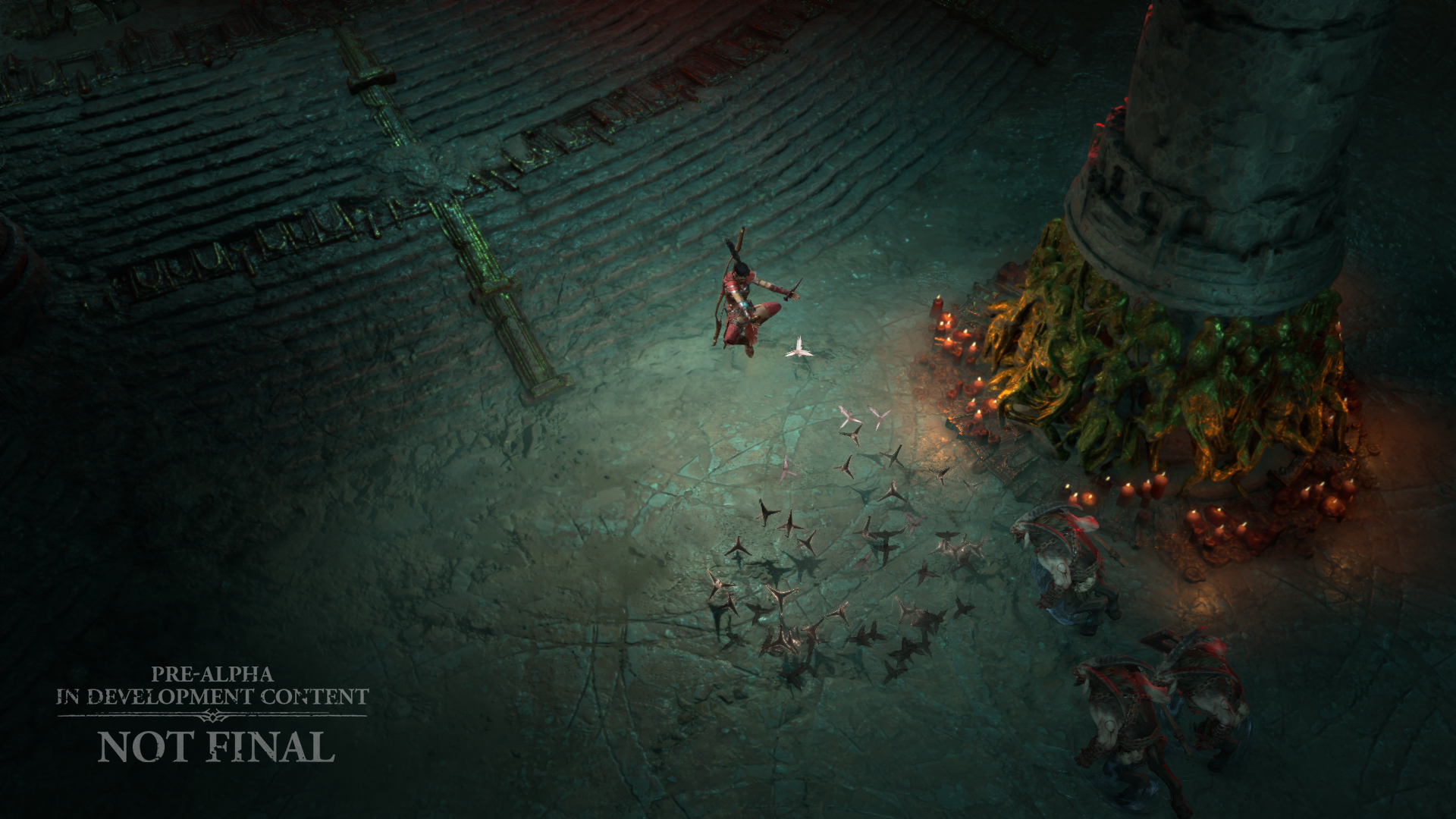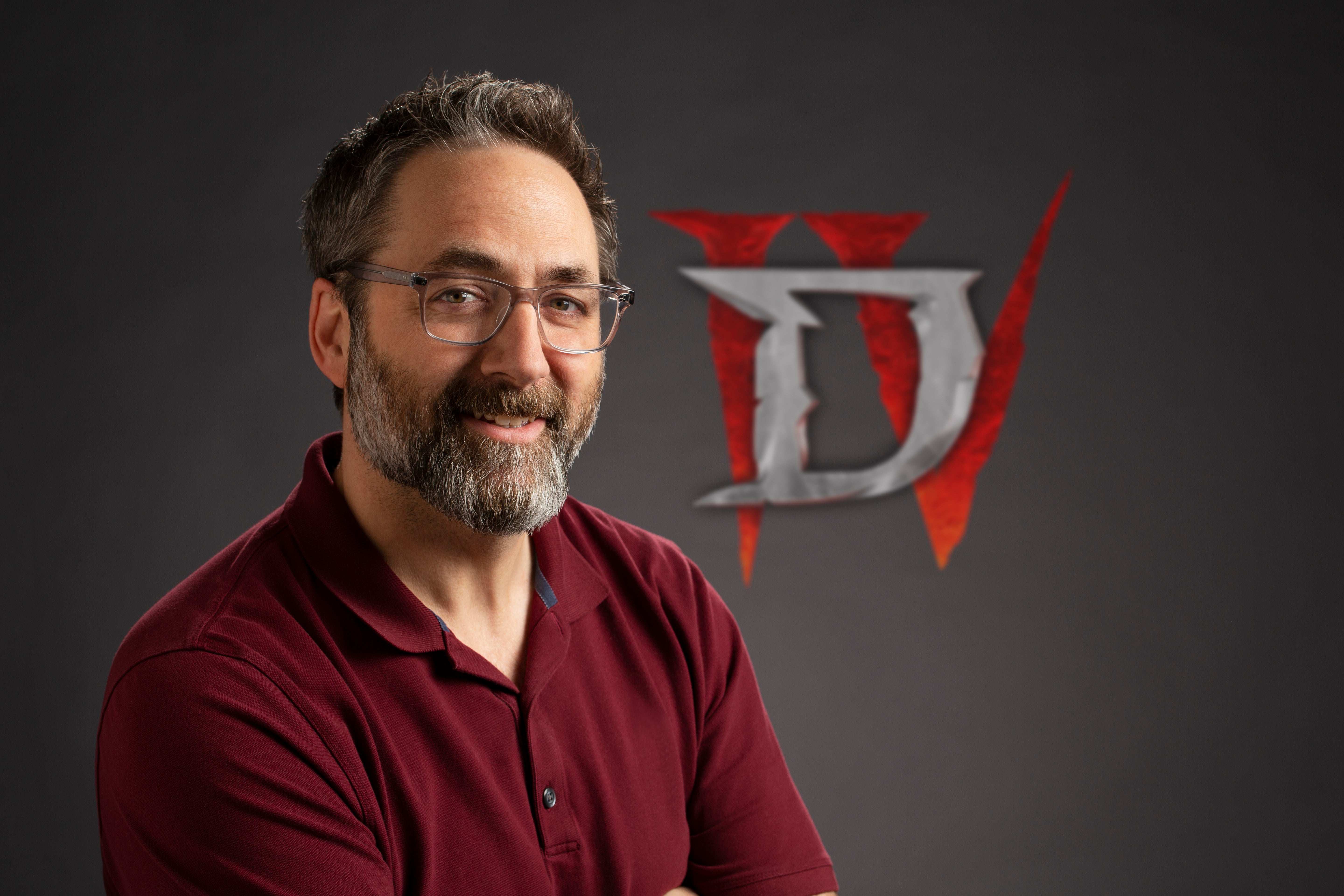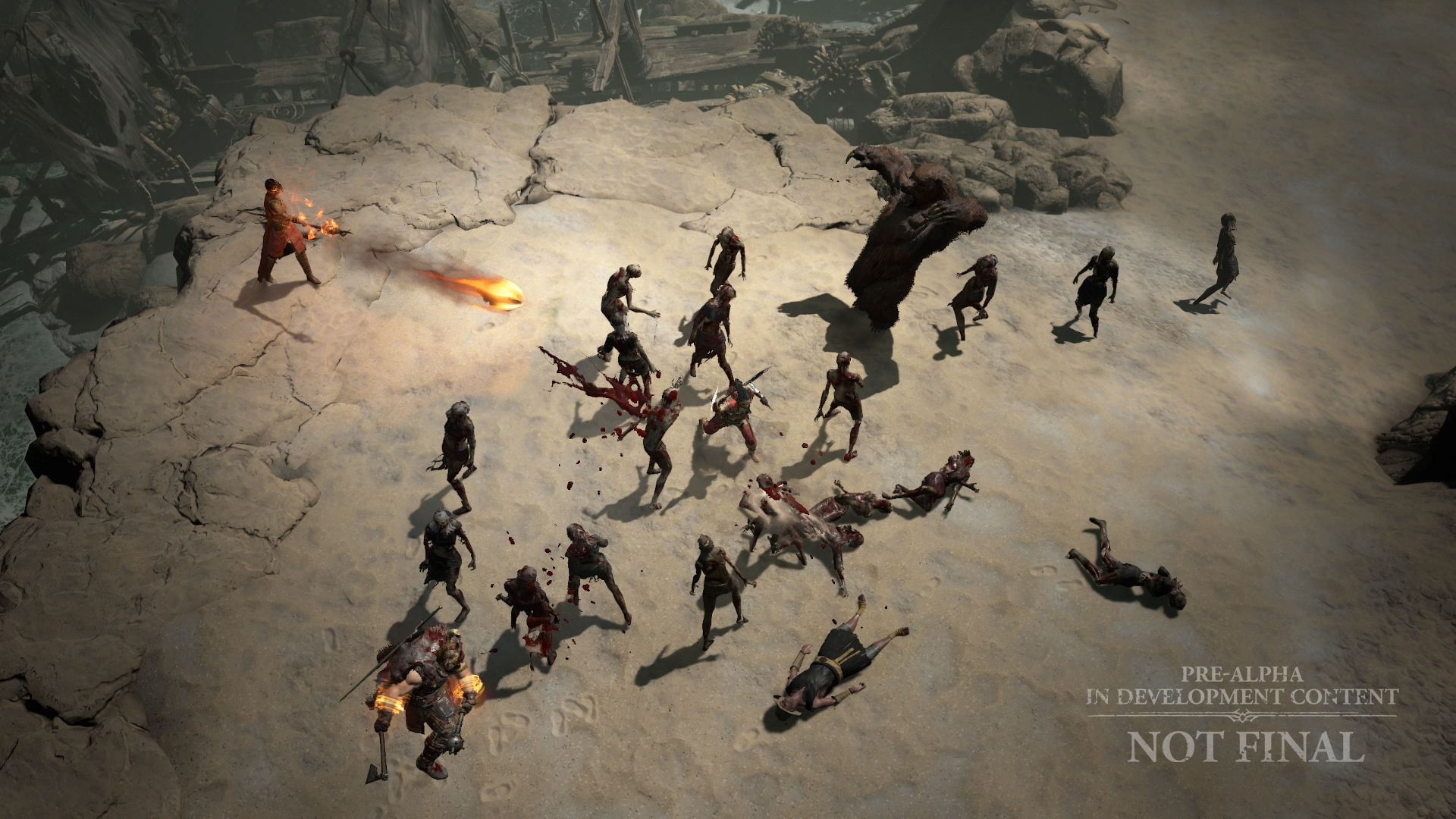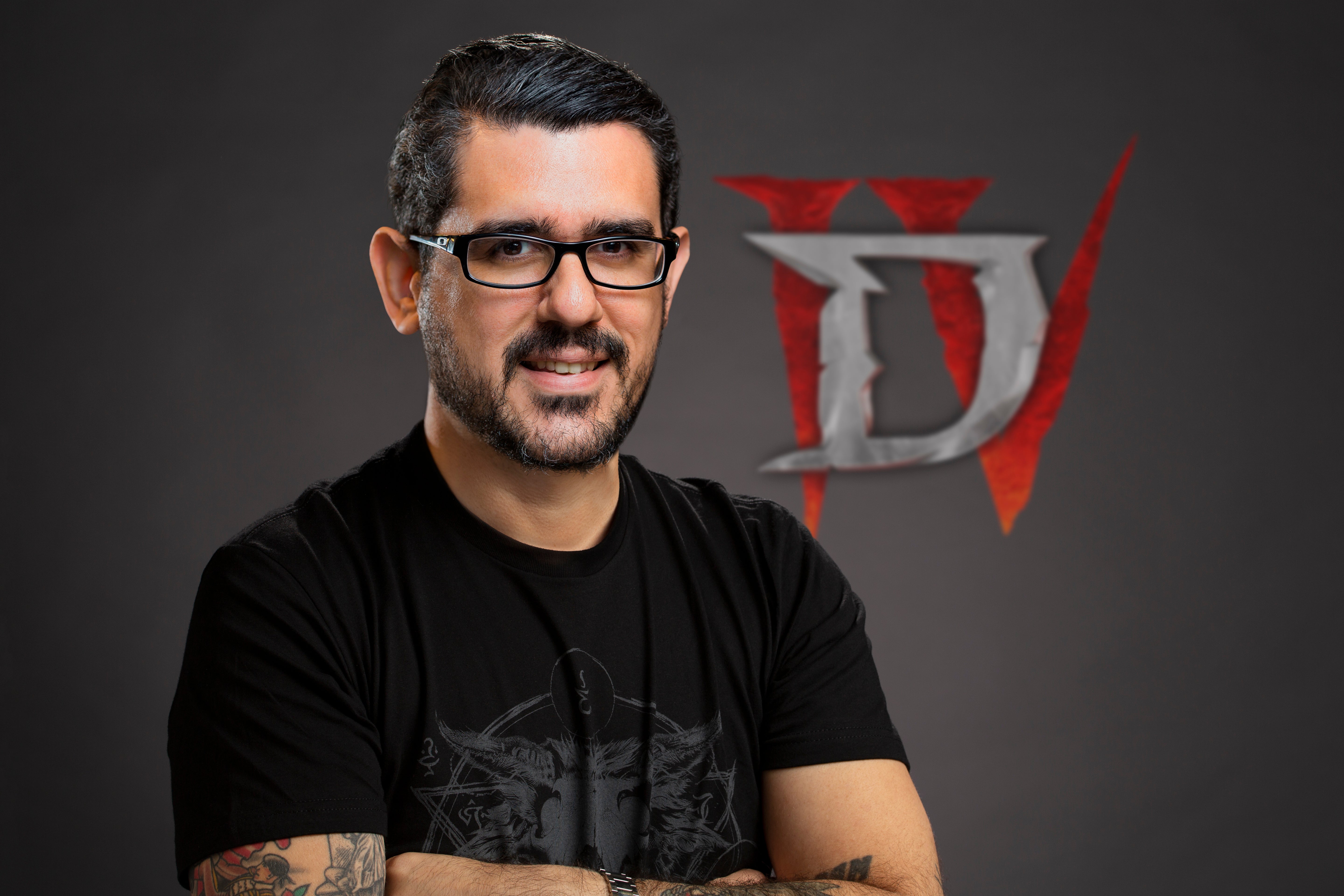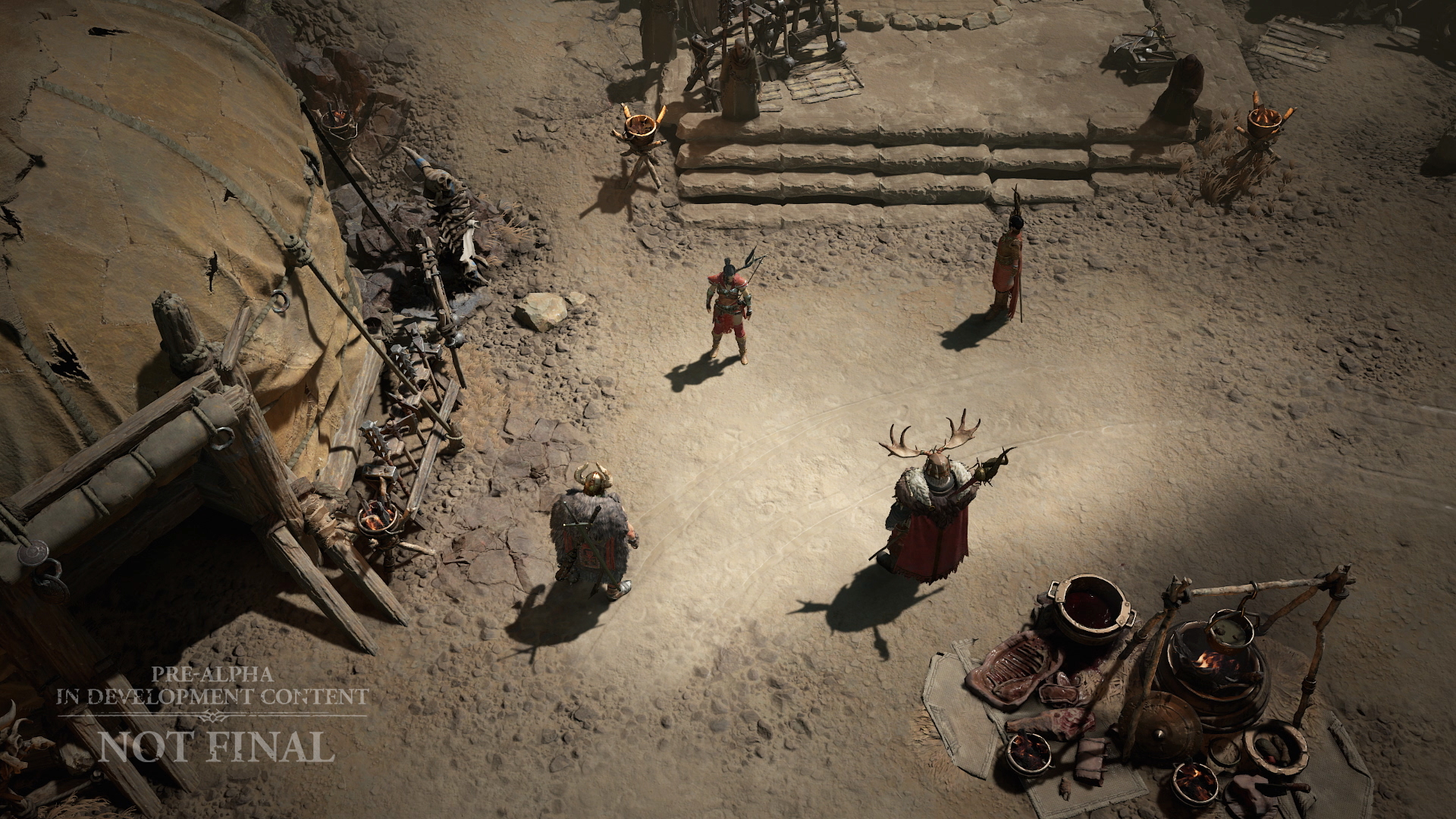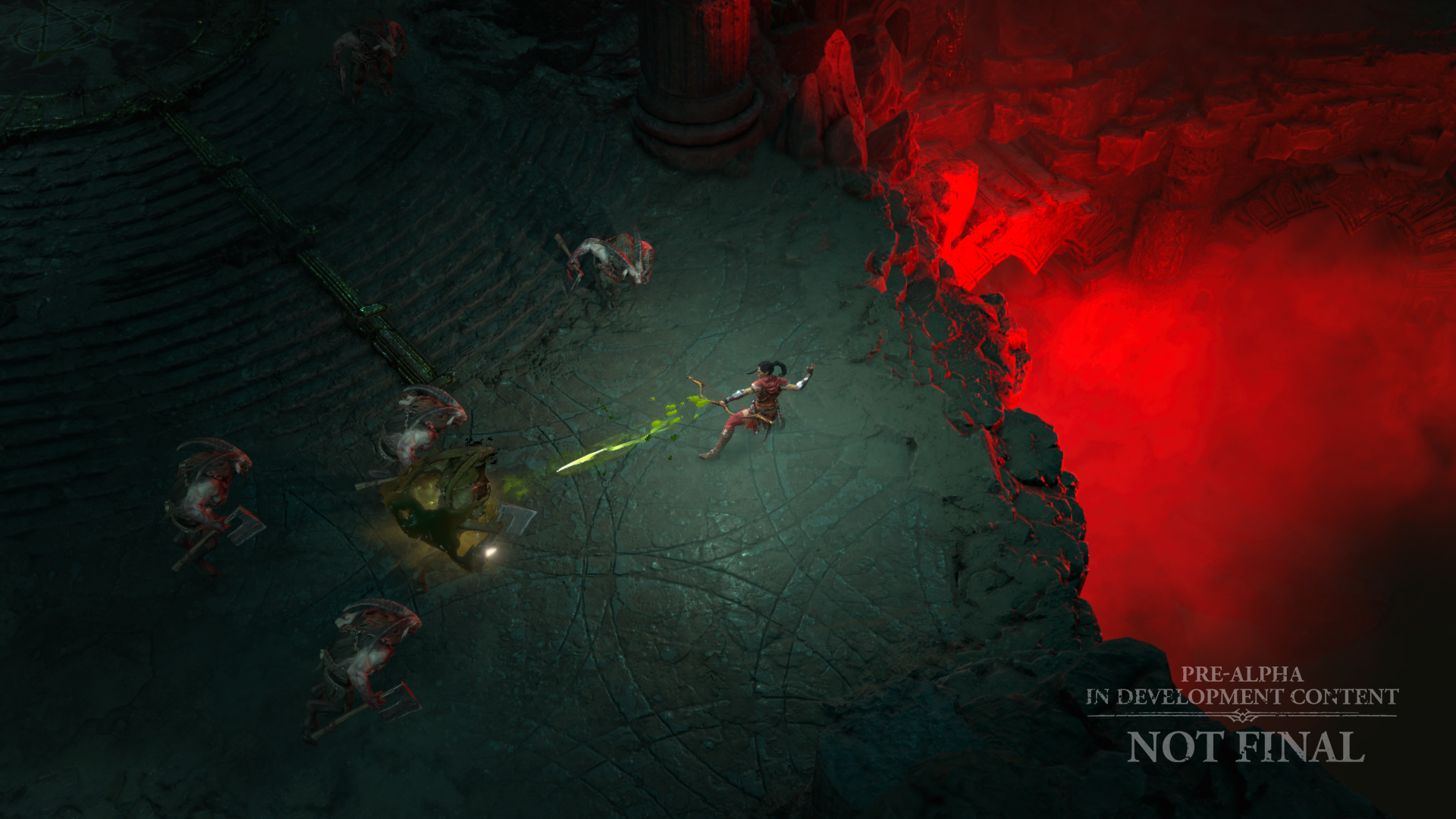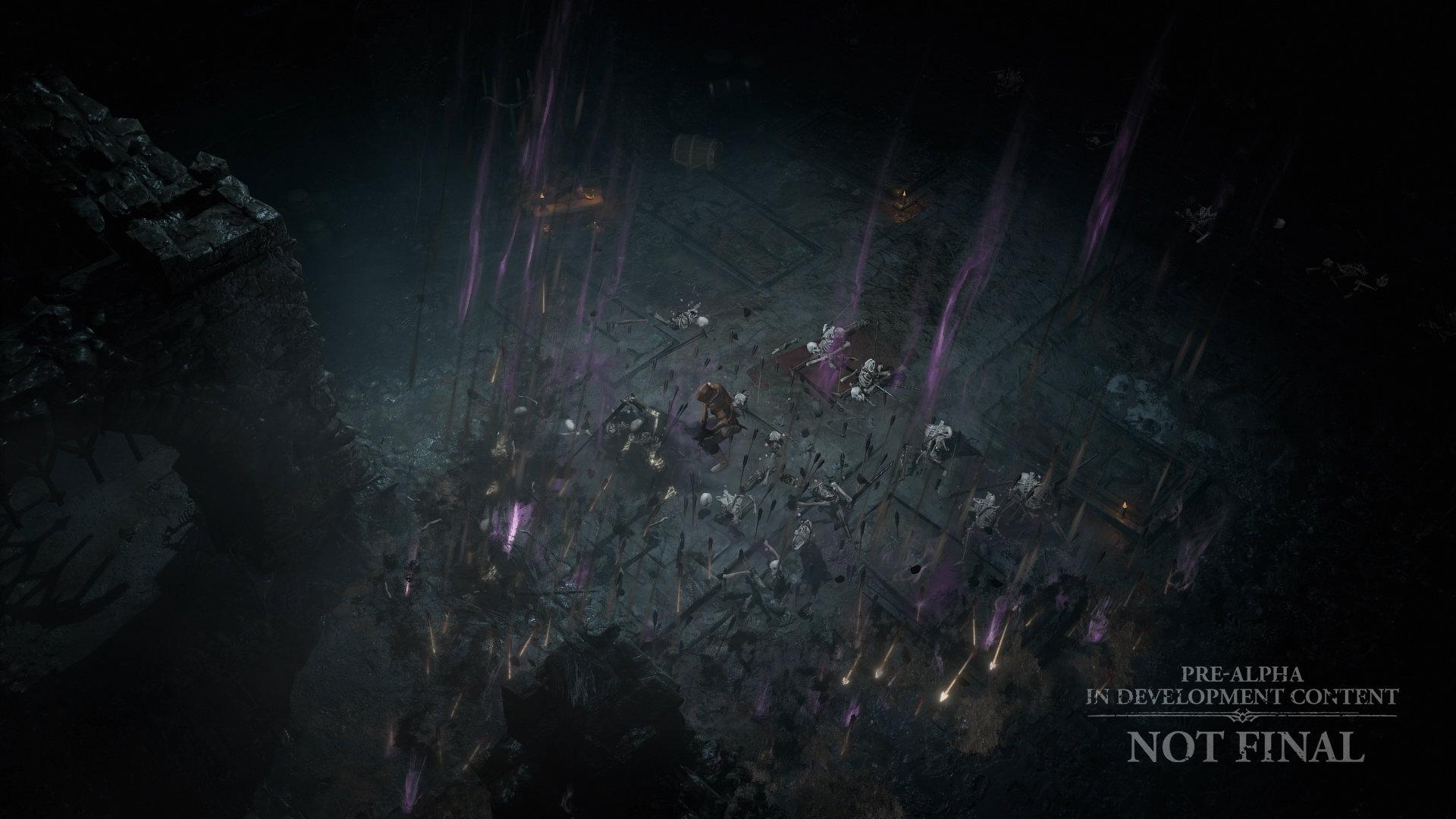Why did you bring back the Rogue for Diablo 4? Luis Barriga: We felt like with the lineup that we were slowly building up, with the Barbarian, the Sorcerer and the Druid, the Rogue gives us this awesome two-in-one capability of representing that finesse dexterity class, both on the melee side and on the ranged side. Of course, on the ranged side, that’s the archetypical Diablo 1 rogue. And then on the melee side, fans of pen and paper RPGs, that’s like the Rogue’s bread and butter. So we felt that was the perfect opportunity to speak to all the players that love that finesse type gameplay, fast-paced combat, very different from the Barbarian as an example, that whether they want melee, whether they want ranged, or whether they want a hybrid approach, the Rogue gave us that canvas to paint on it. We also love the legacy the Rogue has in the franchise, where it was a playable class in the first game. It was a great mercenary addition in the second game. And they have some ties into the lore. Of course, we’ve expanded it. You don’t have to play a Rogue that looks like they’re part of The Sisterhood of the Sightless Eye. You can play an outlaw from the streets of Caldeum, or a smuggler from the swamps of Hawezar. Whatever the Rogue character that’s in your head, you have a lot of customisation options there. John Mueller: We basically started with the little pixels of Diablo 1 as a jumping-off point of interpreting this into a modern game engine. So we’ve really had a tonne of fun with it. People know what to expect with the class, but we get to interpret that into more of like the bandit, the outlaw, the brigand, the cutthroat in this Diablo 4 lens that we’ve put on everything, which is this return to darkness and a grittier, realistic take on things, which has been a lot of fun. You’ve definitely gone for a darker approach in terms of the look, feel and tone for the game. What motivated that decision? John Mueller: Diablo 3 had this beautifully hand painted, handcrafted, look about it. But Diablo 2 had this very gritty, realistic take on things. The opportunity with this game was to find the sweet spot between the two. We’re not trying to make things look like photographs. We’re trying to make things look painterly. One of the things we talk about, we call it the old masters pillar - the goal is to make it feel like a mediaeval masterpiece. If you think of mediaeval artists, Renaissance paintings, like dark paintings from mediaeval times, there’s angels and demons and mankind caught in the middle. It’s very much rooted in our own history. That was where we started with it and we’re really happy with where we’ve landed now. People have given us some good feedback about the look of the game, and so that just encourages us even more. Luis Barriga: When Diablo came out, there were many high fantasy RPGs. Diablo stood out because it was darker, grittier, it had angels and demons instead of high fantasy themes. We wanted to make sure there was absolutely no confusion that when you fire up Diablo 4, it was a return to those darker roots. We wanted to take our favourite parts of every Diablo game, and one of the things we liked especially from the earlier Diablo games was that tone, that sense of dread that there was as you were playing the game. John Mueller: It’s like the dark tone of Diablo 2 but some of the painterly feeling of Diablo 3. There’s a lot of beauty in the world. The open world of Sanctuary is absolutely gorgeous to explore. The dungeons are very dark. And that’s where it’s like, it’s full dark. There’s more naturalistic situations like caves and things like that. But then there’s the more horrific stuff that we do, like City of the Ancients. Then there’s the stuff above ground, which we want it to feel like you’re exploring a mediaeval world, and that’s not bleak. Darkness should not be confused with bleakness. There’s a strong sense of colour, but not heavily saturated. It’s more naturalistic, like paintings tend to be. If you look at Old Masters paintings, they’re painting realism, but it’s done in a very beautiful, artistic way. So that’s what we’re trying to accomplish. It’s been some time since you last showed off Diablo 4’s open world. Has that dynamic open world evolved in any meaningful in the last year? Luis Barriga: Players will see a lot of refinement, a lot of iteration, a lot more details. We spoke at a high level in 2019 that we wanted the world of Sanctuary to be a place where players could meet other players, where they could choose to trade or to fight each other. This time around, we’re showing some details about how PvP works in the world. We have these areas that were cursed long ago by Mephisto. So it’s not everywhere in the world, but pockets within zones that were cursed by Mephisto long ago. Where maybe the villagers will tell you, don’t go past that statue, it’s a little bit dangerous there, my friend went there and didn’t return. Now, with the return to Sanctuary of the daughter of Hatred, these areas that have laid dormant for so long are now getting back to activity. So now when you go there, the rules change a little bit. Fans of D2 will be really familiar with it - there’s a mechanic to go hostile against other players. So while the rest of Sanctuary, you have a lot to fear, but generally you’re safe from other players - if you run into another player on the road, you might nod at them and go on your way - but here, everyone could be a potential ally or enemy. It’s a mechanic we really like. Even if you’re not a deep fan of PvP, it adds a lot of tension and like, oh, man, there’s an objective there that I really want to do. Do I get in and out? What’s my tolerance for being ambushed by a roving band of hostile players? But also, you might think that somebody is your friend and then maybe you take too much of the reward after defeating a boss and all of a sudden, those RP whispers of Hatred actually become a real thing that you feel as a player. Like, hey, John’s taken all my loot, maybe I’ll go hostile and claim some of these chards for myself. It’s a mechanic we’re having a lot of fun with in playtests. John Mueller: It’s integrated into the open world. You know when you enter one of the Fields of Hatred. But there’s also the Shards of Hatred that drop in those regions, and there’s PvE content. That’s how I tend to play it. While I’m not a huge PvP player, I like some of the gear and the rewards from the PvP vendors. So I’ll go in and do some of the events or try to kill one of the bosses, which adds this element of tension because you never know if somebody might come in and try to go hostile on you while you’re doing stuff like that. Luis Barriga: If you renounce the error of your ways you can turn off your hostile flag back in town, have a priest absolve you. But if you’re the kind of player that’s really into PvP, and you’re like, no, I want people to know that I’m here to gank them, we have a really cool mechanic called the Vessel of Hatred. The more people you kill and the longer you remain hostile, you become marked on other people’s map. So now they know there’s somebody really dangerous around. So they know to stay away, or to try to form a group to try to take you down. John Mueller: Yeah, you also have a lot of shards because you’ve been killing players! Luis Barriga: Right. After farming shards against monsters for a certain while, you might have like 100 or 200. If someone sees a Vessel of Hatred, and they know they haven’t turned in those shards, they might be in the thousands. You’re a very attractive target! The more high-skilled players on the team really enjoy that mechanic. They’re kind of like sharks circling the waters. It sounds very backstabby! One of my questions was going to be, can I gank as a Rogue, but clearly you can gank as a Rogue in this game! John Mueller: Yeah. It’s a perfect mechanic for the Rogue. With some of the specialisations you can ambush pretty well, like with the Shadow Realm specialisation. Luis Barriga: If you don’t like PvP, you’re not forced to go into these areas. We entice you with some rewards, but there’s nothing mandatory here. There’s nothing like that. You don’t need to be there to beat Lilith or anything like that. There’s other cool stuff in the open world. If you’re a pure PvE player, the camps feature is really going to speak to you. Diablo 4 takes place after the events of Diablo 3, when Malthael decimated humanity. So you might have these places of importance that once had human inhabitants, like churches, or lighthouses, or strongholds and forts and things like that, that have fallen or are now cursed to have like vengeful ghosts or demons. Maybe someone did a pact with someone they shouldn’t have. Each one of them has its own backstory. You find them through exploration in the world, you complete the combat there, and then you flip them into a friendly encampment, where now NPCs are approaching, you might see vendors, quest givers, maybe one points you to a newly-opened dungeon. But also you will see other players in these small encampments. They might be there to approach a unique vendor, but also because it gives you access to a new waypoint. It’s a way to get mastery over the world and quickly get through around the world by doing PvE content. I’m getting WOW vibes! Did you take inspiration from MMOs for Diablo 4? Luis Barriga: Many of the MMOs were inspired by Diablo 2! There is so much Diablo 2 DNA… point me at an MMO and I’ll be like, here’s where all these ideas came from from Diablo 2. The ideas are well-developed in MMOs like World of Warcraft, which I love and play it and have worked on a bunch of myself. We’ve taken some of those ideas and applied them in a in a very different scale. We think that Diablo 4 with this vision of like, post-apocalyptic, almost humanity struggling to get by, doesn’t feel super right when it’s more players than NPCs in a field where you’re fighting over spawns, and where a villager feels like yeah, I could have my pick of like 10 adventurers or 20 adventurers to help me with a mundane problem that I have. So it was really important for us that players are almost there to remind you that you’re lonely and all on your own when you go into dungeons. So, on your way to the dungeon, you might see one or two people and it really adds something to the game because you’re like, wait, wait! I need to ask this person where they got the trophy, or I need to ask them if like they can point me in the right direction because they have clearly completed the same quest I’m on. So having those glimpses of seeing other players, as opposed to going into a location where there’s always a huge amount, we find feels really good. And then once you go down that dungeon instance, it’s just you and your party. It’s super familiar Diablo gameplay. We think that the combination is working super well. John and I spent countless hours over the break just playing the game. We’re huge fans of Diablo obviously, but we also play a lot of open-world games. And we’re like, yeah, this is ticking all the boxes for us. So we really like the way that it’s going. John Mueller: There’s a feeling when you’re in the open world, if you see another player you want it to be scarce enough that you’re curious and not annoyed. Like, why is this person intruding on my space or taking my loot or something like that? That would feel really bad in Diablo. When we would encounter somebody it was always like, oh! Who’s that? What are they doing out here? And sometimes you group with them, or maybe they’re running the same quests. But it’s pretty rare, which makes it cool. The world events, though, when you know you’re going to take on something really big, that’s when you want to have more players and it makes it more engaging because you see lots of different players with lots of different play styles and builds and gear. That feels really good in the open world. That allows the dungeons to remain pretty much completely intact, the way that people would expect them to be. How many players will world events support at the same time in the same place? Luis Barriga: It’s actually not a hard number. Your party size is still four. But then we have heuristics to group people and shard people and things like that. So it can vary. If a ballpark helps, it’s about two to three times the size of a party, roughly, because we want that flexibility as you invite people to not have to now split off into two shards and things like that. So it’s a number that actually fluctuates a little bit, as opposed to saying, it’s always 12 people, go! It’s a floating number that goes up and down, depending on people adding new people to the party. How do you balance these world events difficulty wise for players of different skill and power levels? Luis Barriga: There’s definitely some amount of math that goes into the encounters like that, that are balanced for a group. They scale a little bit. So basically, if you have below a certain threshold, you shouldn’t expect that these are tuned for you. So if you’re below a certain level, you might not be ready to do these. And if you don’t see other players around you might not be able to do them at all. But, whether you have eight or 10 players, there’s a certain adaptability we have when we spawn the boss to make it the correct difficulty for that group. While these are challenging, and they do require a lot of people, they don’t require the super intricate teamwork of MMO raid fights. You don’t need to make a hard party to be able to take on these. They’re more organic events. We want to create the impression that this is something that is going to take more effort than just a single player. We zoom the camera out. We make sure you understand this is gonna be a dangerous thing. You do need to pay attention to the mechanics, but it isn’t the sort of demanding, like, okay guys, we wiped, let’s try it 12 times or whatever. That’s not the expectation. We do have areas where you push content, but they don’t happen in these organically matchmade areas. Key dungeons is an example of something that caters to to players that progress more and more. Diablo 4 is non-linear, where players can go to any act they want at any time. In terms of telling the story, how do you manage that? Luis Barriga: There’s definitely pieces. So there’s a beginning, there’s an end. And there’s some zones that you can do in any order. But there’s definitely a sequence to which zones are in this part, versus a zone that comes in at the end. So that’s how we’ve taken that approach. Players of big world RPGs should be pretty familiar with the structure. There’s a few variants out there of it. For example, you get this moment where you have a choice to go into one of three zones, and you can do them in any order. But at some point, the story is gonna converge and everything makes sense. Now you’re ready for that ending motion in the story. John Mueller: In practice, you’ll get caught up in side quests and other things and other objectives, and you’ll do a little bit of story, and then you’ll go off and do something else. The world pulls you around a little bit, just by the nature of this kind of space. I found it to be really refreshing to not be locked into, like, I have to do the campaign. I can do it at my own pace, and it really doesn’t prohibit my feeling of progression. I’d love to talk about damage numbers. I’m a big fan of Diablo 3 but the numbers are now very high - into the billions. What’s your philosophy for Diablo 4? Will you scale them lower so they’re more meaningful? Luis Barriga: Diablo 3 didn’t start there. We got there over time. Players should expect that your character will feel like they are getting more powerful, but we’re absolutely trying to keep the numbers under control. We’re absolutely trying to make sure that out the gate, it puts us in a place where we’re not going like, two months in we’re talking about doing a squish or anything like that. So, I absolutely agree. The one caveat is, it’s still a Diablo game. Even in Diablo 2 that progress you feel towards the higher levels, that you do feel more more powerful, is still there. So it’s something we want to tap into in Diablo 4, that there’s a cool feeling to your progression as a character, that you do feel much more powerful at max level than at level one, but then we don’t get into stratospheric numbers out the gate. We do also have some philosophies in place that we’re talking about that maybe will prevent us from getting into those high numbers. As an example, we’ve talked about being more okay with nerfing things. After a season ends and before the next one begins, you might see some nerfs to keep things under control. That’s one of the things that maybe there was a little bit of a difference in philosophy that can lead to that creep. But over time, I would expect that as we add more content, those numbers might get a little higher. We’re gonna try to do everything we can to keep them chill, but at the end of the day, if it ends up being the sacrifice of like, oh man, this is what feels good, and it’s like, maybe going from a certain number to a little bit higher, that’s something we can tolerate. But I agree with you - we want to avoid being in the billions out the gate! You’ve said the world is inhabited by deadly monster families of thematically linked creatures, and that they work together to present interesting strategic challenges. How does that play out in the actual game? Luis Barriga: It’s something we’ve seen in a more concentrated capacity with the fallen before in all the Diablo games. Any player who’s played Diablo remembers fallen shaman rez the fallen. So there’s a mechanic that’s specific to that interaction, where a shaman on their own isn’t that big of a problem, but if there’s a shaman at the edge of the screen who’s resurrecting the fallen, these little guys can be a real threat. I kill three, use up my cooldowns, now all of a sudden they’re coming back. So, it’s leaning more on that idea, that each monster family has synergies within them, or has a little bit more of an identity. That’s the crux of it. And then the other part about it is, because we’re a world-based game, each family has, hey, this is our turf, like a territory. An example is the drowned. If you’re in the desert, you’re probably not going to run into very much drowned. But if you’re in a coastal area and you start seeing bells, you’re like, okay, this is where the drowned hang out. So if you have some objectives to complete that require killing them, you start associating them with places in the world to create that sense of place. John Mueller: It’s hard to explain until you really play it, but really having a sense of place. When I get a bounty to go kill drowned, I know I’m going to the coast in Scosglen because that’s where I’ve learned that they are. I’ve learned the map. I’ve learned the locations of things. You start not knowing anything, and then your sense of mastery of the world really starts to emanate out as you play the game. The monster families are all tied to different areas that makes sense for them. And they have culture kits that go with them, so it looks like they’ve inhabited that area, whether it’s bandits or fallen or demons, there’s a logic to it.
